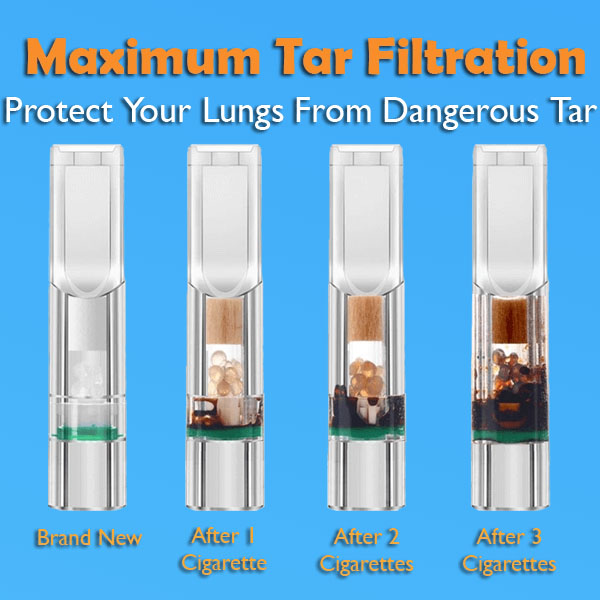
In the world of smoking, innovation has continuously evolved to mitigate the harmful effects of tobacco consumption. One such innovation that has garnered attention is the anti-tar filter. In this article, we delve into what these filters are, their composition, effectiveness, and the benefits they offer to smokers.
What Are Anti-Tar Filters and How Do They Work?
Anti-tar filters are devices integrated into smoking products, primarily cigarettes, to reduce the amount of tar and other harmful substances that reach the smoker’s lungs. They function by employing various mechanisms to trap or absorb tar particles as the smoke passes through the filter. These mechanisms include physical barriers, chemical reactions, and adsorption processes.
What Material Are They Made Of?
Anti-tar filters are typically composed of materials designed to effectively capture tar particles while allowing the passage of air and other gases. Common materials used in these filters include cellulose acetate, activated charcoal, and various synthetic fibers known for their adsorption properties. These materials are carefully selected and engineered to optimize filtration efficiency.

Do Anti-Tar Filters Work?
The effectiveness of anti-tar filters has been a subject of debate among researchers and health professionals. While these filters can indeed reduce the tar content in cigarette smoke to some extent, studies suggest that smokers may compensate for this reduction by inhaling more deeply or smoking more cigarettes. Additionally, the presence of other harmful substances in tobacco smoke raises questions about the overall impact of anti-tar filters on health.

Benefits of Anti-Tar Filters:
Despite the controversy surrounding their efficacy, anti-tar filters offer several potential benefits for smokers:
1. Reduced Tar Intake:Anti-tar filters can help reduce the amount of tar and other harmful substances that smokers inhale, potentially lowering the risk of certain smoking-related diseases.
2. Improved Taste and Odor:By filtering out tar and other impurities, these filters may enhance the taste and aroma of the smoke, providing a more enjoyable smoking experience for some users.
3. Perceived Health Benefits:Smokers who use cigarettes with anti-tar filters may perceive them as a safer alternative, leading to a sense of reassurance and potentially encouraging healthier smoking habits.
What is the difference between third generation and first generation anti tar filters?

The evolution of anti-tar filters in smoking products has seen significant advancements from first-generation filters to third-generation filters. Here are some key differences between the two:
- Filtration Efficiency:
- First-generation anti-tar filters typically employed basic filtration mechanisms such as physical barriers or simple absorption materials like cellulose acetate. They were designed to capture larger tar particles but were less effective in trapping smaller particles and volatile compounds.
- Third-generation anti-tar filters utilize advanced filtration technologies, including a combination of multiple layers with different properties. These filters are engineered to capture a broader range of tar particles and volatile compounds, resulting in higher filtration efficiency compared to their predecessors.
2. Composition:
- First-generation filters were often composed of cellulose acetate or other basic materials with limited adsorption capacity. These materials could capture some tar particles but were not as effective in reducing harmful compounds in cigarette smoke.
- Third-generation filters utilize a variety of advanced materials, such as activated charcoal, synthetic fibers, and proprietary blends designed specifically for enhanced adsorption of tar and other harmful substances. These materials are carefully selected and engineered to maximize filtration performance.

3.Design and Structure:
- First-generation filters typically had a simple, single-layer design with limited surface area for filtration. They were primarily focused on reducing visible tar stains on the filter and cigarette.
- Third-generation filters feature complex, multi-layer structures with increased surface area and optimized pore sizes. This design allows for more efficient capture of tar particles and volatile compounds while maintaining airflow and preserving the smoking experience.
4.Effectiveness:
- Due to their basic design and limited filtration capabilities, first-generation anti-tar filters provided only modest reductions in tar and harmful substances compared to regular cigarettes.
- Third-generation anti-tar filters are engineered to achieve higher levels of tar reduction and overall filtration efficiency. While they may not eliminate all harmful compounds in cigarette smoke, they offer a significant improvement over earlier filter designs.
What is the difference between double filtration and triple filtration filters?
Double filtration and triple filtration filters are two variations of smoking device filters designed to reduce the amount of harmful substances inhaled by smokers. Here are the main differences between them:
- Number of Filtration Stages:
- Double Filtration: As the name suggests, double filtration filters have two stages of filtration. Smoke passes through two separate filtration mechanisms before reaching the smoker.
- Triple Filtration: Triple filtration filters, on the other hand, have three stages of filtration. Smoke passes through three separate filtration mechanisms before reaching the smoker.
2.Filtration Mechanisms:
- Double Filtration: In double filtration filters, each stage typically employs a different filtration mechanism, such as physical barriers, absorption materials, or chemical reactions. These mechanisms work together to capture a wide range of harmful substances present in smoke.
- Triple Filtration: Triple filtration filters also utilize multiple filtration mechanisms across the three stages, providing an additional layer of filtration compared to double filtration filters. This additional stage allows for enhanced filtration efficiency and potentially greater reduction of harmful compounds.
3.Filtration Efficiency:
- Double Filtration: Double filtration filters offer an intermediate level of filtration efficiency between single filtration (traditional filters) and triple filtration. They are designed to capture a significant portion of tar, nicotine, and other harmful substances, providing a cleaner smoking experience compared to traditional filters.
- Triple Filtration: Triple filtration filters provide the highest level of filtration efficiency among the two options. With an additional stage of filtration, they are capable of capturing more tar, nicotine, and other harmful substances, thereby offering potentially greater health benefits for smokers.
4.Size and Design:
- Double Filtration: Double filtration filters may have a slightly smaller size compared to triple filtration filters, as they consist of two filtration stages instead of three. However, their design can vary depending on the specific product and manufacturer.
- Triple Filtration: Triple filtration filters are typically larger in size compared to double filtration filters, as they incorporate an additional filtration stage. This larger size may affect the overall design and appearance of the smoking device.

The transition from first-generation to third-generation anti-tar filters signifies a significant advancement in smoking technology, boasting improvements in filtration efficiency, composition, design, and overall effectiveness, reflecting ongoing efforts to develop safer smoking alternatives. Meanwhile, the disparity between double filtration and triple filtration filters lies in the number of filtration stages, employed mechanisms, efficiency, and size, with both options aiming to mitigate the inhalation of harmful substances, with triple filtration providing an additional layer of filtration for potential health benefits.
Anti-tar filters emerge as a pivotal development in reducing the health risks associated with smoking, offering potential advantages for smokers seeking a cleaner and more enjoyable smoking experience, albeit with varying effectiveness and ongoing debate surrounding their overall impact on health. Staying informed about the latest advancements in smoking technology is essential in making informed choices that prioritize personal well-being and promote harm reduction strategies in tobacco consumption.

